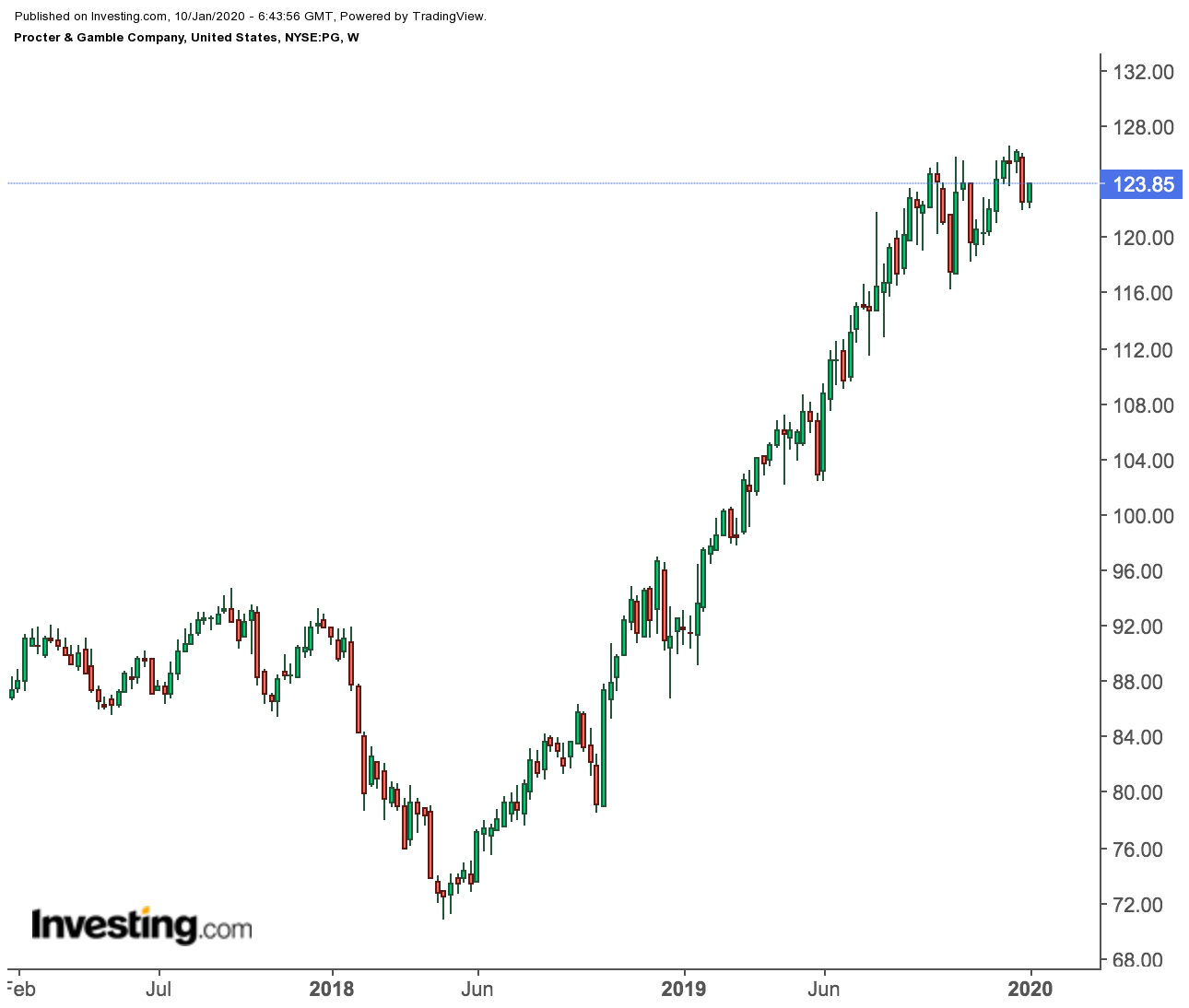Shares of global consumer staples giant Procter & Gamble (NYSE:PG) have had a great 2019. Investors sent the stock soaring to a record high after seeing five consecutive quarters of explosive growth and building in strong expectations for the current year.
The shares of the world’s largest maker of household products surged to $126.60 on Dec. 2 after a remarkable turnaround over the past 18 months. The stock closed at $122.51 on Thursday, up about 37% in the past year.
During the past two years, the maker of Dawn dish-washing soap, Bounty paper towels and Crest toothpastes has consistently been growing its sales, helped by its innovation, marketing and a simplified organizational structure.
In October, P&G reported organic sales, which exclude things like acquisitions and currency fluctuations, rose 7% in its fiscal first quarter, showing the company is keeping up the momentum after it matched the previous quarter’s fastest organic sales growth in more than a decade.
But the pace of growth that P&G is showing is unusual for a company which produces everyday consumables in categories where the competition is intense and margins are low. From a big consumer staple giant like P&G it wouldn’t be fair to expect a blow-out quarter every time.
During the same period, Kleenex and Huggies maker Kimberly-Clark (NYSE: NYSE:KMB) reported organic sales growth of 4%, while Reckitt Benckiser (NYSE:RBGLY) the U.K.-based maker of Lysol cleanser and Woolite detergent, reported disappointing organic growth of just 1.6%.
These concerns have made some investors question P&G’s lofty valuations and its potential for providing further upside after such a fast and powerful rally.
Today, P&G trades at 23.42 times forward earnings compared to its five-year average of around 20. Over the past decade, the stock has never featured a forward earnings multiple this big. To put things in perspective, both Alphabet (NASDAQ:GOOGL) (NASDAQ:GOOG) and Facebook (NASDAQ:NASDAQ:FB) are forecast to grow their profit more than 20% against the single digit growth for P&G. These high-growth technology stocks are trading at around 24 times forward earnings.
Another factor that could take some of the steam out of P&G shares is that, because of its defensive nature, it attracted a lot of cash last year as fear of a global recession grew amid the U.S.-China trade war. Once that dispute settles, or the risks to growth recede, investors might again shift their funds to riskier assets, hurting P&G stock.
P&G: “Most Underweight ” Consumer Stock
These concerns could be valid for short-term investors, but we think measuring P&G stock performance on these metrics doesn’t present a true picture of the company’s growth potential. What’s fueling these share price gains is the company’s success in its turnaround strategy to cope with changing consumer needs and putting itself much ahead of competitors.
Under Chief Executive Officer David Taylor, Cincinnati-based P&G has cut its roster of brands from 175 to 65, focusing on the 10 product categories where the margin is highest. During the course of that process the company has also eliminated 34,000 jobs through a combination of brand sales and buyouts, as well as plant closures—slashing more than $10 billion in costs.
These measures are clearly helping the company to seek higher prices for its products despite a very benign inflationationary environment. P&G started implementing phased price increases last summer after failing to revive growth by doing the opposite. The shift in pricing strategy will be completed by February, which could boost prices between 4%-10% on products including its Pampers, Bounty, Charmin and Puffs brands.
Goldman Sachs, while upgrading P&G stock last year, tried to quell overvaluation concerns by pointing to the company’s strong growth momentum in organic sales that could continue over the next three years. Said Goldman in a note:
“We believe there is a role in investors’ portfolios for a large liquid global staples company such as this and note that PG remains the most underweight U.S. listed mega-cap global consumer packaged goods company among mutual funds.”
Bottom Line
P&G stock remains our favorite pick from the packaged consumer goods companies. It's one of the largest dividend payers in the U.S. — distributing $2.98 per share annual dividend for a yield of 2.6% — and a track-record that's hard to match. The maker of Pampers diapers has raised its payout for 62 consecutive years. Now that growth is back on track, investors should expect more hefty dividend hikes and we see little reason to abandon this consumer powerhouse, even if its stock goes through some weakness.
